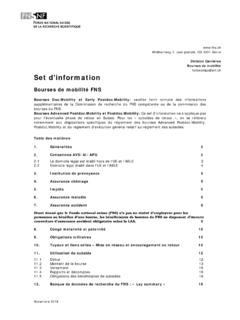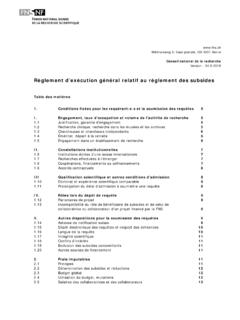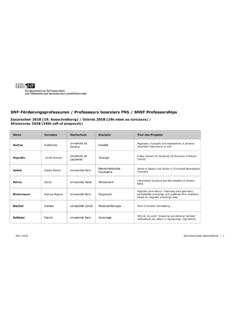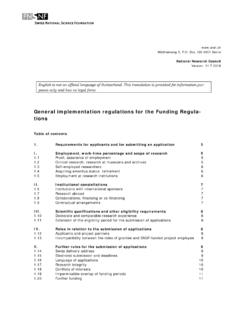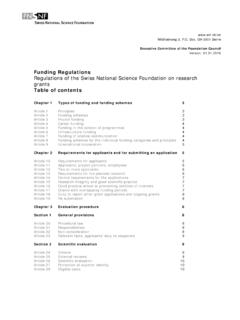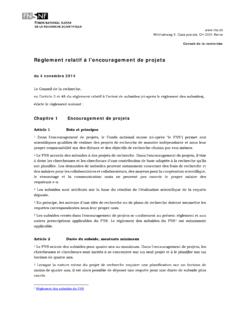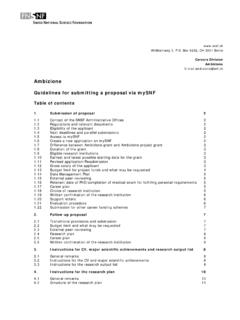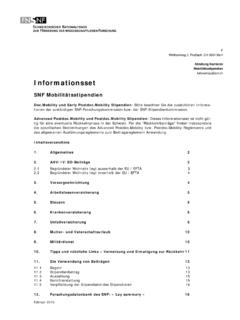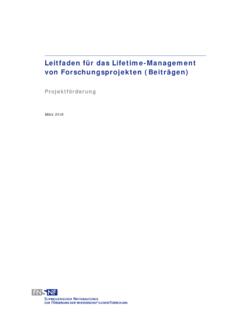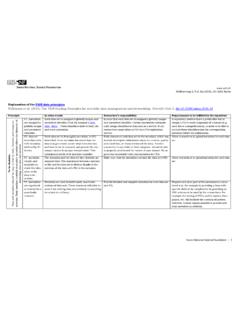Transcription of grants, and blanket amounts for social security ...
1 Wildhainweg 3, Box, CH-3001 Berne National Research Council Version: Annex 12: Salary ranges, guidelines for employees funded under SNSF grants, and blanket amounts for social security contributions (Clause et seq. General implementation regulations for the Funding Regulations) Introductory comments Three categories of employees are funded under SNSF grants: " doctoral students ", "postdocs" and "other employees". This categorisation is based on the employee's official status under the grant. This status must be clearly communicated to the SNSF. The SNSF's commitment to promoting young researchers is an important part of its research funding mandate. This implies that SNSF-funded employees should not remain in any of these three categories over a long period of time. The target for doctoral students is to complete their dissertation in good time. The maximum funding period for doctoral students is four years.
2 For postdocs, the goal is to become scientifically independent as soon as possible so that they can compete at an international level and maximise their academic career prospects. The maximum funding period is five years. The aim in employing other personnel is to ensure that each project is adequately staffed with qualified personnel who make specific contributions. Therefore, employees in the category "other employees" may not be funded uninterruptedly under an SNSF grant over a long period. The SNSF's research funding mandate does not include permanent financing of project employee positions at institutions. Salary range for doctoral students The salary range below sets out the gross salary of a doctoral student (excluding social security contributions by the employer). The salary of a doctoral student may not go below the minimum of the salary range regardless of their work-time percentage. If the salary is funded from more than one source, the total amount must be at least as high as the minimum of the salary range.
3 For doctoral students , a minimum "protected time" of 60% is in place (Clause General implementation Regulations for the Funding Regulations). doctoral students CHF 47,040 to 50,040 General implementation regulations for the Funding Regulations of the SNSF | 2 The maximum period of employment funded by the SNSF for doctoral students is four years. For details regarding the period of employment and the minimum work-time percentage, see also Clauses and of the General implementation regulations for the Funding Regulations. Salary ranges for postdocs and other employees The following salary ranges are annual gross salaries, excluding social security contributions by the employer, calculated on a full-time basis. For lower work-time percentages, the amounts must be reduced accordingly. Postdocs CHF 80,000 to 105,000 other employees (see rules below): CHF 40,000 to 105,000 The category "Other employees" comprises: employees with a degree who do not intend to do a doctorate; employees with a doctorate who are not included in the postdoc category due to their period of employment and eligibility period; technicians; auxiliary staff.
4 General guidelines The following general guidelines shall apply to the employment of personnel under SNSF grants: Institutions may apply their normal salary standards within the salary ranges. Institutions are responsible for ensuring salary equality within their institutions. The work-time percentage (in percentage terms) of project staff charged to the project grant must correspond to the actual time spent working on the project. Other employees' salaries can only be covered by an SNSF grant if they make a specific contribution to the project. Salary costs of other employees may not be charged to SNSF grants uninterruptedly for a long period. With regard to uninterrupted funding by the SNSF, all SNSF-fu nded employment positions and fellowships starting at the doctoral level are considered. Funding gaps of a few months are not regarded as an interruption in SNSF funding. No career measures may be requested for other employees.
5 For the purposes of budgeting, vacant positions (NN-positions) must be taken into account at the most at an average rate within the corresponding range and with no incremental increase. Exceptions to this rule have to be justified in the application. NN positions for doctoral students may be entered in the budget with annual adjustments (salary for first to fourth year) if the relevant salary range is respected. The salaries charged to the grant may not be higher than the salaries actually paid and may therefore not include any additional costs such as, for instance, overhead costs. The SNSF approves positions for doctoral students at universities of applied sciences and universities of teacher education where there is a well-documented scientific cooperation with a university in Switzerland. As a general rule, the SNSF does not approve positions for doctoral students who are matriculated abroad. Exceptions include the departments of universities of applied sciences and universities of teacher education for which there are no partners at university level in Switzerland.
6 General implementation regulations for the Funding Regulations of the SNSF | 3 Adjustments to salary ranges The regular review of the salary ranges is delegated to the SNSF Administrative Offices. They shall have the final say in adjustments up to the level of the general development of salaries that has occurred since the previous adjustment. However, there is no mandatory requirement to match the general development of salaries. Adjustments exceeding the general level shall be decided by the Presiding Board of the Research Council. Adjustments will generally enter into force on 1 January and will be communicated to the institutions in advance. blanket amounts for social security contributions For employees remunerated via an SNSF grant, the SNSF pays the grantees the equivalent of the statutory social security contributions required to be paid by employers in accordance with AHVG/IVG/EOG, BVG, AVIG and UVG (Swiss federal acts on social security contributions) as well as any family allowances, if applicable, or any other benefits commonly paid at the place in question in the form of blanket amounts , for simplicity's sake.
7 In the financial reports, the actual amount incurred for social security contributions must be entered. The blanket amounts1 for the employer's share in the social security contributions are as follows (as a percentage of the relevant total gross salary): University of Basel 14 % University of Bern 15 % EPFL 16 % ETHZ 16 % EAWAG, EMPA, PSI, WSL 16 % University of Fribourg 19 % University of Geneva (incl. IHEID) 23 % University of Lausanne (incl. CHUV) 16 % University of Lugano 14 % University of Lucerne 16 % University of Neuch tel 22 % University of St. Gallen 14 % University of Zurich 15 % Other institutions, usually 16 % 1 Clause of the General Implementation Regulations.
